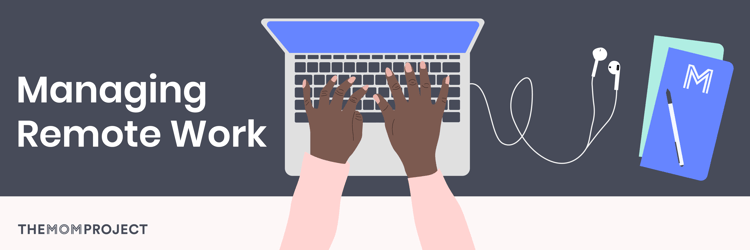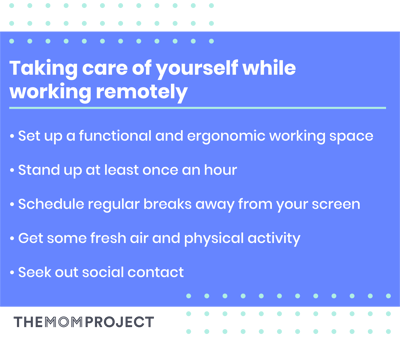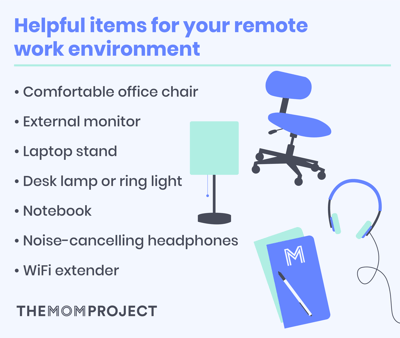New to working remotely? Start off on the right foot for success.
Like any role, working remotely has both pros and cons. You will be more in control of your own work life and hours which means enjoying flexibility for the rest of your schedule. You can take walks to clear your mind, eat lunch with your kids, enjoy an afternoon yoga class or fit in doctor’s appointments when it makes the most sense for you. All definite pros.
But working remotely also means that you are more responsible for getting things done on your own, with less regular supervision and interaction with other people. If no one is going to see you for the day, what’s your motivation to get out of those sweatpants or actually leave your couch workspace for a more productive environment?
Welcome to the combination of freedom and discipline that you have to learn how to manage in order to be successful! Don’t fret though. We are here with some tips and tricks to help you manage yourself, your environment and your tools when working remotely.

Managing yourself in a remote role
Get organized
First, if you have the option, decide what your working hours will be. Create a working schedule and stick to it for yourself. If you say you’ll start at 9, be ready to start at 9. If you plan to end your day at 5, step away from the computer when the clock strikes the hour. This can help ensure you are working the correct amount of time, not too little and not too much.
And be sure that once you have set hours, you inform your boss, colleagues and family of your schedule. Your coworkers need to know when you’ll be available for work tasks and meetings, and your family members need to know when you will not be available to them. Creating this routine will benefit everyone in your sphere.
The big opportunity here is to give yourself structure in your workday without the standard structure of an office environment. With set hours and a routine, you can be an employee that is reliable and prepared for the day ahead. Rolling straight out of bed and into a meeting doesn’t help set you up for success as you might feel discombobulated and that will show up in many ways throughout the day.

Being self-motivated
In a remote role, you’ll have to go the extra mile to make sure you understand what is expected from you. This means you need to get comfortable taking the initiative to understand your role and responsibilities instead of just waiting for your manager to tell you what to do. And if you have any questions about any projects you are working on ask them immediately. Remote work and assuming do not play well together.
You also need to be proactive and take initiative to get things done without being constantly reminded, monitored or pinged for progress updates. Clear communication is key to be a remote worker and you have to be motivated enough to reach out to the people on your team as necessary.
Learn to work with distractions
In a remote environment, you’ll also need to learn how to work through distractions. The pile of laundry that needs to be folded. The kids that are asking for help with a snack. The Instagram notifications on your personal account. These (and plenty of other things) are a more immediate distraction when working remotely. You have to come up with a plan or system for putting aside personal distractions in your remote work environment.
One tip is, if you notice yourself becoming distracted or losing focus, take stock of what is distracting you and come up with a solution to get back on track. Or imagine ahead of time what might become a distraction and work to negate it before you ever even encounter it.
Communicate clearly and promptly
Now is the time to take your communication skills to the next level, no matter how good you are already. As a remote worker, you’ll have to try harder to connect with your team members.
See if there is an opportunity for virtual coffee chats or happy hours or if there are any initiatives to help remote workers connect with each other and other team members. Use any and all tools at your disposal to connect with people you are working with - email, phone calls, video calls, online chat software and whatever else you can find can all help improve your work relationships.

Be prepared to over-communicate to make sure you and your team members are collaborating effectively and your manager knows what you’re doing. You cannot assume everyone knows what you are working on or what your status is on a project if you aren’t updating them. Consider implementing some sort of update processes like Geekbot in Slack or a quick, daily standup call so everyone can hear from each other.
And, if you aren’t already, get comfortable with asynchronous communication. Every email, chat and videoconference needs to be effective and often you’ll receive responses from people at varying times from your own working hours.
It’s impossible to emphasize this enough, but if you want to succeed at working from home, you absolutely must focus extra time and energy on communicating clearly, promptly and frequently with your colleagues.
Prioritize self-care
Don’t forget to prioritize your needs. Since you’ll likely have fewer reasons to get up from your desk when working remotely you need to consciously take regular breaks. Get up every hour to grab some fresh air and prevent yourself from sitting at your desk for too long. Set an alarm at the end of the workday if you need the signal. Schedule a lunch break in your calendar and take it away from work. And make sure you are getting enough physical activity regularly. We often don’t realize how much more we move when we go to work in an office.
Working remotely can also get lonely. To help combat this you can listen to music or podcasts while working. Make sure you are actively seeking out social contact, not only with family members, but also community members. And consider investing in a co-working space if you can to help you meet other remote workers.

Managing your environment
The beauty of remote work is the freedom you have in your environment. The downside is that you can end up working slouched over on a couch if you don’t pay attention to your environment. It is important to designate a specific workspace. This is preferably a separate room, a coworking space or even a favorite coffee shop. If that is unavailable though, at least find room for a small desk space to help your frame of mind and your posture.
This separation of work space and personal space can also help with avoiding distractions. It puts you in a better mindset for getting work down. And it allows you to enjoy your personal spaces when you are done working for the day.
If you choose to work from home or a noisy environment, you may want to consider investing in noise-canceling headphones. A strong Internet connection and a WiFi extender are also good investments for a remote office at home. And don’t overlook the benefits of a comfortable chair. Some companies will provide stipends or reimbursement for these materials so be sure to check to see if that is available to you.

Potential tools for success
If you aren’t already, your first order of business should be to get very comfortable with technology. Remote communication and collaboration tools such as instant messaging, video and web conferencing (Zoom for example), project collaboration and document sharing tools are the most common. Find out if your company has a preference and learn what you can about any tools new to you.
One of the best tools for success as a remote employee will be the use of your calendar, especially if you work with people across multiple time zones. Be sure you set small breaks for yourself throughout the day (five to 15 minutes) and a block of time for lunch (at least 30 minutes) to move away from your screen. Also, carve out one or more larger blocks of time regularly to ensure you can get work done instead of becoming sucked into back-to-back calls all day long.
Task management is also essential to the successful completion of a project. This can involve creating a to-do list, scheduling tasks in a calendar or tool such as Asana and learning how to best prioritize your tasks based on due dates and urgency level.
Final thoughts
Working remotely will be different for each person so be prepared for differences in your own work. Some things will take longer at home than at the office and vice versa. If you are prepared for this to happen you’ll have an easier time with the transition.
If you can make it happen, meeting your team in person every now and then is a good idea. It is much easier to get to know your colleagues on a personal level when meeting face-to-face, which helps you better understand team dynamics. Whether once a month, quarter or half-year, it's useful to have a regular cadence of visitation with your team. In this way, everyone knows what to expect, and certain activities can be planned during your visit.
And having a friend or close coworker in the office to share feedback from other departments or company news that isn’t shared formally is also important. This can help you understand what’s happening with other teams and keep you in the loop of the day-to-day things you may miss out on as a remote worker.
Working remotely is a fantastic opportunity, as long as you know how to set yourself up for success and remember to focus on yourself, your communication and your environment in different ways for a different set of circumstances.
Join a community that cares
Navigating work and parenting is a balancing act. Join The Mom Project to access job opportunities, career development resources and connect with a network of professionals that value work and family. 



